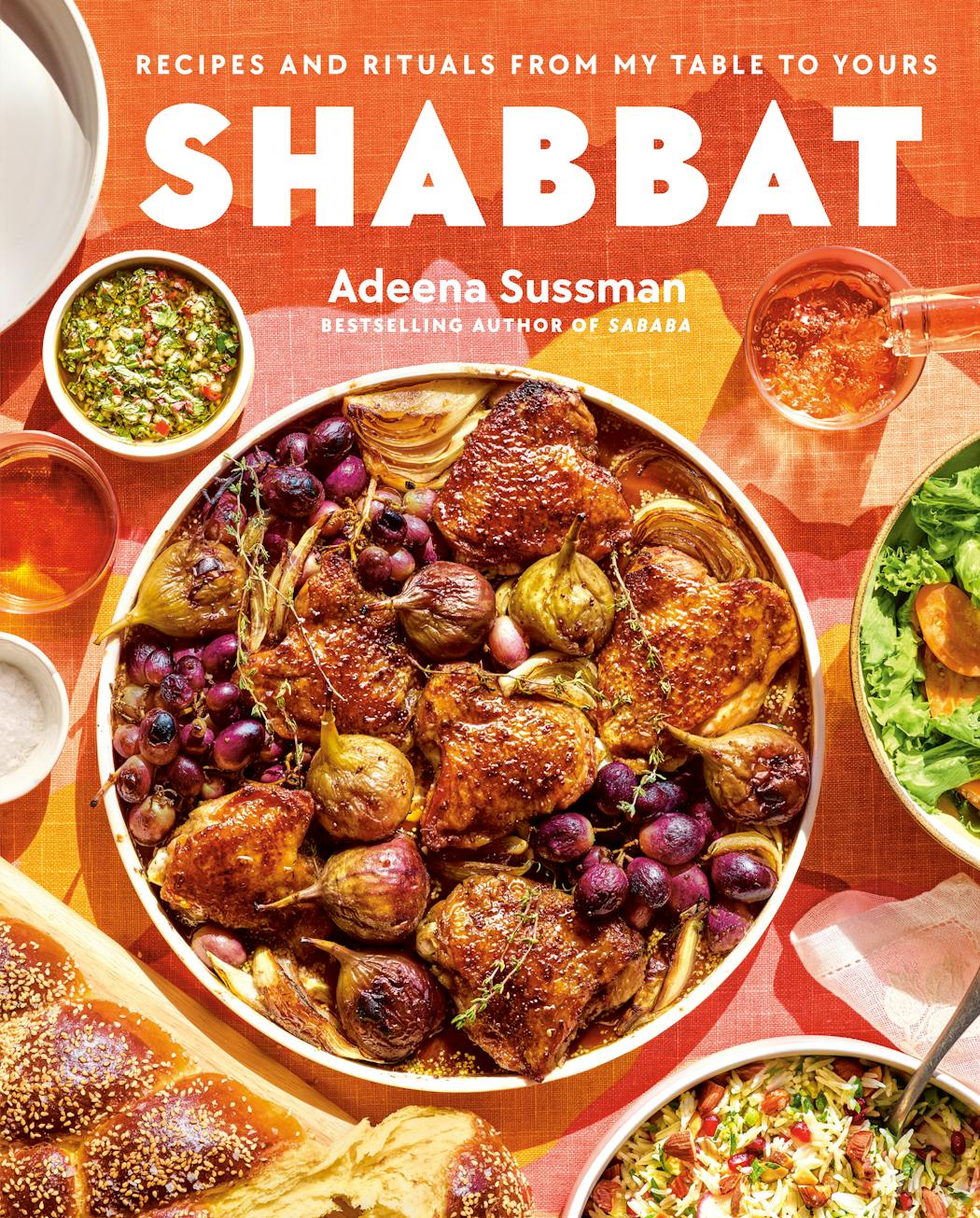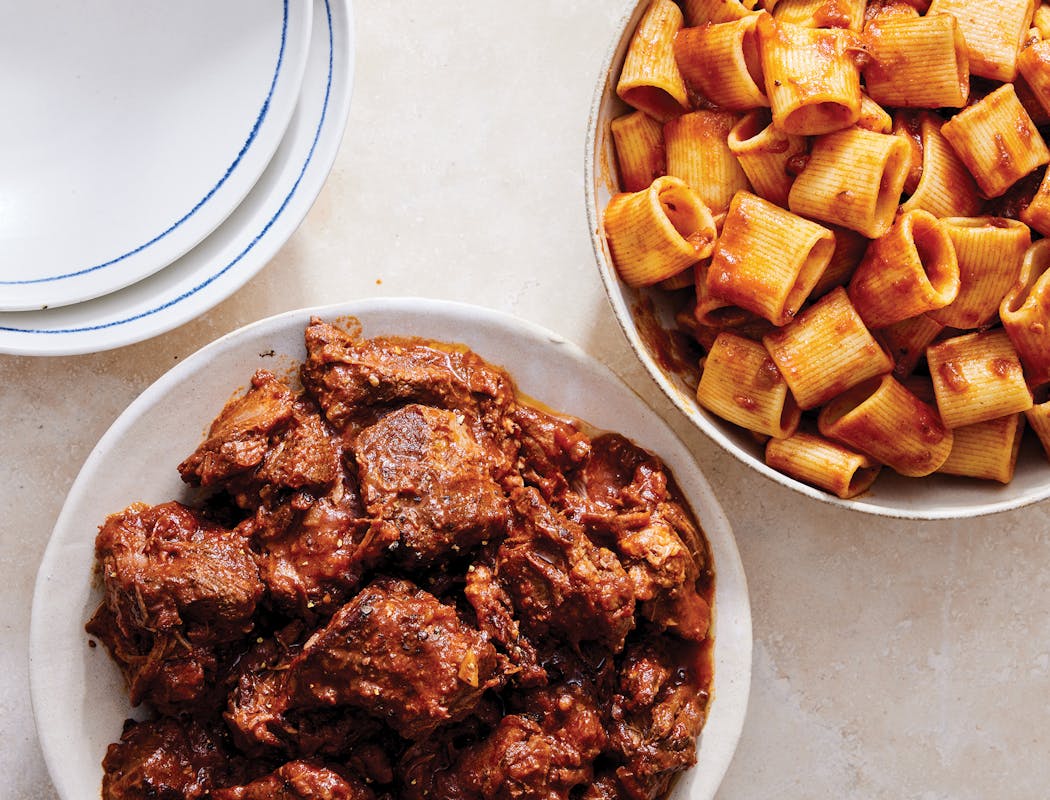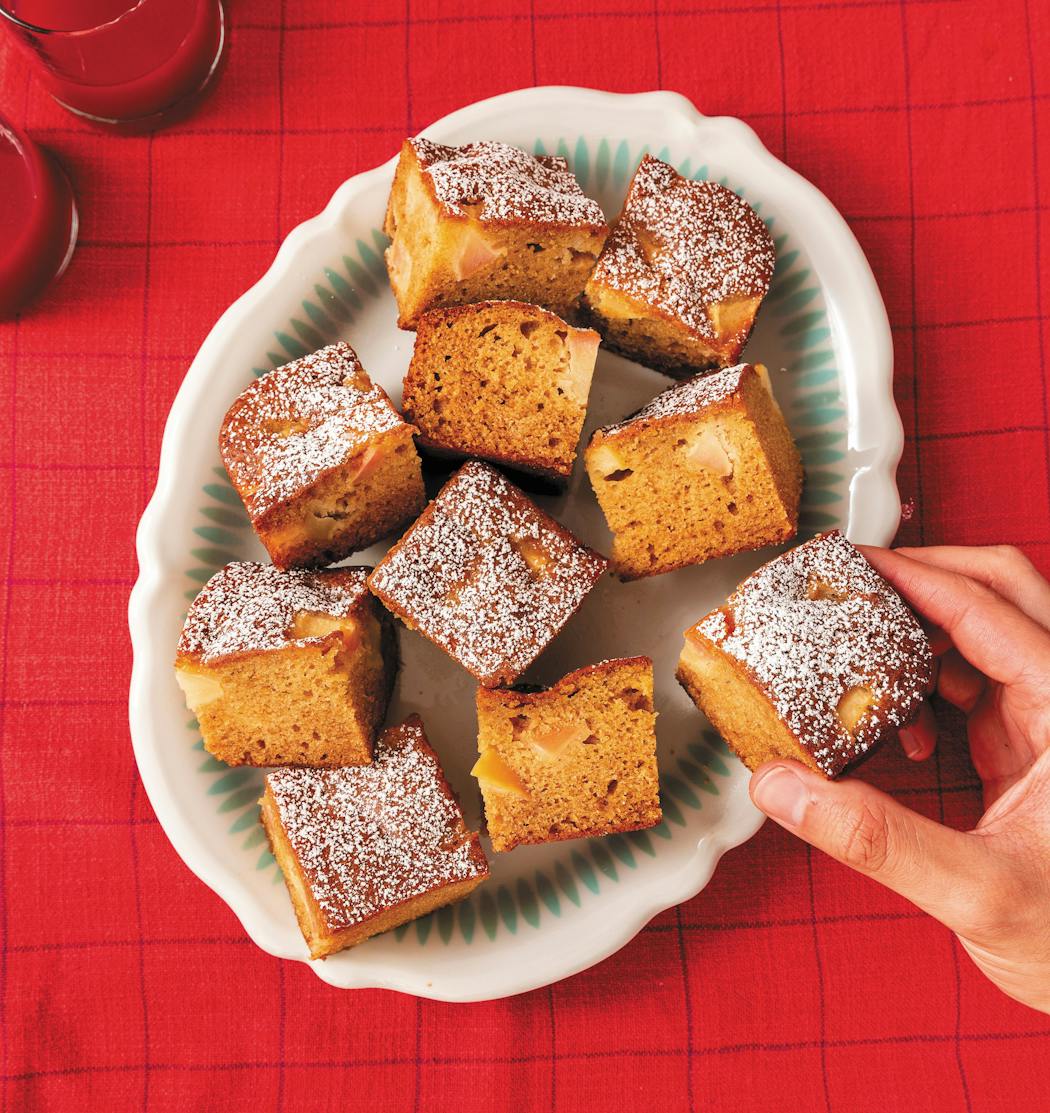What is a nosh?
Though it has a Yiddish origin, "nosh" is used enough in English slang that most tend to understand the implications. It's a snack, but it's more than that: It's food served with love.
"Noshing is a lifestyle, versus a physical thing," said Jake Cohen, author of "I Could Nosh: Classic Jew-ish Recipes Revamped for Every Day."
"It's this idea of hospitality and feeding and having intention of making sure those around you are fed, in a way that's not unique to just Jews, but something that is so prominent in our culture."
In that sense, three new cookbooks on Jewish cuisine all celebrate the art of the nosh. There's the new book from Cohen, who has mastered the intersection of culture and whimsy with his playful delivery of Jewish and Middle Eastern recipes on Instagram and TikTok.
There's "Portico: Cooking and Feasting in Rome's Jewish Kitchen," by Leah Koenig, one of the most prolific authors on global Jewish cuisine.
And there's "Shabbat: Recipes and Rituals From My Table to Yours," by Adeena Sussman, who explores the multiplicity of ways Jews observe the day of rest through food.
These three volumes all were released in the weeks leading up to the Jewish High Holidays, which begin Sept. 15 with Rosh Hashana, the new year.
This latest abundance of recipes is a sign, the authors say, that readers and home cooks are understanding Jewish food not just as a niche, but as a multifaceted umbrella of cuisines influenced by more than religious dietary restrictions. Everything from immigration patterns to terroir affects flavor as much as the logistics of cooking Kosher. (Kosher dietary restrictions prohibit the consumption of pork and shellfish, and the mixing of meat and dairy. Additionally, the act of cooking is prohibited during the Sabbath and many holidays, requiring those celebratory meals to be prepared in advance.)
"I think because of social media and the way that Jewish culture has spread far and wide, people are interested in cooking foods from different slices of cultures — similar to the way I would cook from an Italian cookbook or a Spanish cookbook or an African American cookbook," said Sussman. "These Jewish cookbooks are not just for Jewish people."
With many observers heading into the kitchen to prepare meals for loved ones, each book offers both traditional and unexpected ways to nosh one's way through the season — and beyond.
Shabbat: Recipes and Rituals from My Table to Yours"
By Adeena Sussman (Avery, $35)
Living near one of Tel Aviv's most vibrant markets, brimming with colorful produce, Sussman had endless tools to work with for her exploration of the Sabbath table. She also had her experiences growing up in an observant Jewish home in Palo Alto, Calif., to inspire her; her mother would begin preparing the Friday night meal on Wednesday.
"It's a positive kind of anticipation, knowing that there's a lot of excitement leading up to a very relaxing time," Sussman said. "You're getting ready for the weekend, making sure you have everything you need, and then once Shabbat starts, there's this huge sigh of relief."
For Sussman, now living in Israel, the weekend starts on Fridays, so she has all day to prepare — including mixing dough, letting it rise, and braiding challah. While bread is traditional on many Shabbat tables worldwide, it can come in many forms, from an eggless challah originating in 19th-century Eastern Europe to the Ethiopian Shabbat bread, dabo.
"Shabbat" offers a whole chapter on stews, known as cholent or hamin, that can be prepared well in advance of the day of rest using a slow cooker or an oven set to low heat. There are also recipes for Uzbeki dumplings, Algerian meatballs and Yemenite rolls, for a truly global look at Shabbat cooking.
"The common denominator to all of them," said Sussman, "is that they lead to something that is both very nourishing and satisfying and also extremely relaxing."
Adeena Sussman will be in Minneapolis with Andrew Zimmern Oct. 1-2 for Adath Jeshurun Congregation's special Sukkot event. Join them for Culinary Journeys: A Conversation with Adeena & Andrew on Oct. 1 at 7:30 p.m. at Adath Jeshurun, 10500 Hillside Lane W., Minnetonka. Cost is $50; $80 with a book. Get tickets and more information here. An Oct. 2 dinner is sold out. The event is held in partnership with the Minneapolis Jewish Federation.
"Portico: Cooking and Feasting in Rome's Jewish Kitchen"
By Leah Koenig, (W.W. Norton, $37.50)
In Koenig's celebration of the tastes and aromas coming from the mazelike cobblestone alleys in Rome's Jewish ghetto, traditional dishes such as carciofi alla Giudia — Jewish-style fried artichokes — get their due, while lesser-known dishes, especially those from Libyan Jewish immigrants to Rome, add another layer of flavor to Italian cookery.
The book was inspired by a trip Koenig made to Rome for her honeymoon. "We ate all these dishes that were so different from the foods that I had eaten growing up as an Ashkenazi Jew," she said. "I knew about Sephardic food, I knew about Middle Eastern Jewish food, I knew about Ashkenazi food. But Rome was just its own thing. And that really crystallized for me how deep and diverse the community was."
The recipes are heavily influenced by Italian standards, but with a Kosher twist. Amatriciana, a classic pasta dish traditionally made with cured pork cheek, is made in Jewish households with carne secca, a Roman-style cured beef. And instead of adding cheese to a pasta dish with meat, Roman Jews would grate bottarga, or dried fish roe, for the same salty effect.
"In general, Jews adapt to their surroundings," Koenig said. "And one of the reasons why Jewish food is so interesting is because you have all of these different pockets of communities that have taken the foods of their neighbors and then adapted them and many times moved and brought those dishes with them. It's a constant evolution that makes Jewish food so delicious. Rome is just a really interesting microcosm of that."
"I Could Nosh: Classic Jew-ish Recipes Revamped for Every Day"
By Jake Cohen (Harvest, $35)
Releasing a Jewish cookbook just ahead of the High Holidays, Cohen expects it'll get some heavy use about now, as even less-observant Jews might celebrate in some fashion — often with a meal.
"The New Year's resolution," he said, laughing. "Let's see how long it lasts."
Cohen's brand of recipes is approachable, fun, and unafraid to take liberties with tradition — which can be a sore point for readers who want to see him adhere to the classics they grew up with.
One example is kasha varnishkes, an Ashkenazi Jewish side dish of pasta and buckwheat groats, to which Cohen adds seasonal vegetables like tomatoes in summer, and cabbage in winter. He says that departing from the usual caramelized onion flavor profile makes this his most controversial recipe.
"There are so many people that are going to see some of these recipes and be like, 'That is not X, because you did it differently,'" Cohen said. "My response to that is that's the evolution of Jewish food from the beginning. It's always been these items that have shifted and changed as we've had to flee and move. The only difference is those are typically out of moments of exile and trauma, and now we're in this age of Jewish joy in which we can see these Jewish dishes evolve out of excitement of fun, what's in season, what's trendy."
Other playful entries include a fried challah PB&J, umami-amped brisket, kugel fries and a spin on the traditional apples and honey for Rosh Hashana, in a trendy snacking cake format.
"I am a clown," Cohen said. "I don't like to take myself very seriously."
Recipes
Recipes from three new Jewish cookbooks give you the road map to a delicious holiday meal.
Water Challah
Makes 2 medium challahs.
Note: "In the shtetls of Eastern Europe in the eighteenth and nineteenth centuries, eggs were expensive and hard to come by, so festive and indulgent recipes that did not require eggs were prized for their simplicity and affordability," Sussman writes. "At the Vishnitz challah factory in Bnei Brak, run by members of the Hasidic Jewish sect of the same name, the challahs are made using an eggless recipe often known as 'water challah.' This type of loaf typically produces a darker, crunchier exterior, and I'm not complaining. I brush the challah with a combination of nondairy milk and maple syrup to keep it vegan, and the recipe can easily be doubled." From "Shabbat," by Adeena Sussman (Avery, 2023).
• 1 1/2 c. warm water (110 to 115 degrees, a little warmer than you think), plus more as needed
• 3 tbsp. sugar
• 1 (1/4-oz.) packet active dry yeast (2 1/4 tsp.)
• 3 tbsp. plus 2 tsp. neutral oil, divided
• 4 3/4 c. all-purpose flour, plus more as needed
• 2 1/2 tsp. fine sea salt
• 2 tbsp. almond milk (or other vegan milk)
• 2 tsp. maple syrup or light brown sugar
• 3 tbsp. nigella seeds, black sesame seeds, poppy seeds or seeds of your choice
Directions
In the bowl of a stand mixer, whisk the warm water and sugar (I use a fork — no need to dirty a whisk). Whisk in the yeast and let it get foamy and fluffy for about 10 minutes (if this doesn't happen, your yeast is dead. Start over!). Mix in the 3 tablespoons oil, then add the flour and mix until a shaggy dough forms, adding an additional 1 to 2 tablespoons warm water, if needed, to help the dough come together.
Scrape any dough from the paddle attachment back to the bowl, then fit the mixer with the dough hook and knead for 2 minutes. Add the salt and continue to knead until the dough is smooth and elastic and pulls away from the sides of the bowl, adding flour by the tablespoon as needed, 5 to 6 minutes; the dough should be moist and plush but not sticky. To knead the dough by hand, dump it onto a lightly floured work surface and knead until the dough is plush but not sticky, 9 to 10 minutes.
Lightly coat a large bowl with the remaining 2 teaspoons oil. Place the ball of dough in the bowl, flip it gently to coat, cover with plastic wrap, and cover with a kitchen towel. Let the dough rise at room temperature until the dough has at least doubled in size, 2 to 2 1/2 hours in a colder room, or 1 1/2 to 2 hours in a warmer room.
Line a baking sheet with parchment paper. Uncover the dough, turn it out onto the counter, and cut it into 2 equal-sized pieces. Divide each half into 3 pieces and roll each one out into a rope about 11 to 12 inches long. Let the logs rest for 5 minutes to allow the gluten to relax. Pinch the top ends of the ropes together and braid them, then tuck the ends under, weighing down the pinched end with a chef's knife to secure the dough. Repeat with the second half of dough. Place the loaves on the parchment-lined baking sheet and let rise, uncovered, until fluffy and high, about 1 1/2 hours.
During the last 15 minutes of the second rise, arrange a rack in the center of the oven, and preheat the oven to 365 degrees.
In a small bowl, whisk together the almond milk and maple syrup. Gently brush the tops and sides of the challahs with the liquid, sprinkle with the seeds, and bake until the crust is deeply golden brown and the bottoms sound hollow when tapped, 25 to 30 minutes. Cool before slicing or tearing.
Slow-Braised Beef Stew (Stracotto di Manzo)
Serves 6 to 8.
From "Portico" by Leah Koenig. This iconic Roman Jewish stew is served for Shabbat and holidays, Koenig writes. "Stracotto is typically served as two courses. First, the ample sauce is spooned over rigatoni and enjoyed as a primi. The meat is then served as part of the main course."
• 2 tbsp. extra-virgin olive oil, plus more if needed
• 3 lb. boneless beef chuck, cut into 2-in. pieces
• 2 medium yellow onions, finely chopped
• 2 celery stalks, finely chopped
• 4 medium cloves garlic, finely chopped
• 1 c. dry red wine
• 2 (24.5-oz.) cans tomato purée (passata)
• 2 tsp. kosher salt, plus more if needed
• 1/2 tsp. freshly ground black pepper
• 1 lb. rigatoni, cooked, for serving
Directions
Heat the oil in a large Dutch oven over medium-high heat. Working in batches, add the beef and cook, stirring occasionally, until lightly browned on all sides, 3 to 5 minutes per batch; transfer the beef to a large plate as it is browned. Add a drizzle more oil if the pot begins to look dry. Set the beef aside.
Add the onions, celery and garlic to the pot, reduce the heat to medium, and cook, stirring occasionally, until softened and lightly browned, 8 to 10 minutes. Stir in the wine, raise the heat to medium-high, and bring to a boil.
Add the tomato purée and browned beef (along with any juices that have accumulated on the plate) to the Dutch oven, and bring to a boil. Reduce the heat to low, cover, and cook, stirring occasionally, until the beef is very tender and the sauce is creamy and thick, 2 1/2 to 3 hours.
Stir in the salt and pepper. Taste and add more salt, if desired. Serve hot.
Spoon additional sauce over rigatoni to serve before the stew or as a side dish.
Apples and Honey Snacking Cake
Makes 1 (9-inch) square cake.
From "I Could Nosh," by Jake Cohen (Harvest, 2023). Cohen writes: "Like every schmuck in the Northeast, I go apple picking in the fall with my family. And while it's mainly for the photo ops, we do always end up leaving with a bushel of apples that I have to bake my way through. This is the cake I revisit every fall on repeat, doubling as the perfect dessert to serve for Rosh Hashana. The batter itself blends olive oil and applesauce to create the best crumb, while remaining moist for days, making it a great bake-ahead option. Kissed with honey and packed with chunks of apples, it's just as delightful for a sweet breakfast as it is for a late-night snack eaten hunched over the sink."
• 1 c. olive oil
• 1 c. granulated sugar
• 3/4 c. unsweetened applesauce
• 1/2 c. honey
• 1 tsp. vanilla extract
• 2 large eggs, at room temperature
• 2 1/4 c. all-purpose flour
• 1 tsp. ground cinnamon
• 1 tsp. ground nutmeg
• 1 tsp. kosher salt
• 1/2 tsp. baking soda
• 1/2 tsp. baking powder
• 2 Honeycrisp apples, cored and chopped
• Powdered sugar, for dusting
Directions
Preheat oven to 350 degrees. Line a 9-inch square cake pan with parchment paper, leaving overhang on all sides.
In a large bowl, whisk together the olive oil, granulated sugar, applesauce, honey, vanilla and eggs until smooth. Add the flour, cinnamon, nutmeg, salt, baking soda and baking powder. Gently stir together the dry ingredients piled above the wet ingredients a few times before folding together into a smooth batter. Fold in the apples until incorporated, then pour the batter into the prepared cake pan.
Bake the cake, rotating the pan halfway through the cooking time, for 45 to 50 minutes, until golden brown and it reaches an internal temperature of 190 degrees. Let cool completely in the pan, then transfer to a cutting board. Dust with powdered sugar, then slice and serve. Store leftovers in an airtight container at room temperature for up to 5 days.
Singing, ceremonies and straw hats: Olympics opening ceremony in Tahiti centers Polynesian culture

Three 101-year-old friends recall fond memories in 1940s Alexandria
Celine Dion makes musical comeback at Paris Olympics with Eiffel Tower serenade








